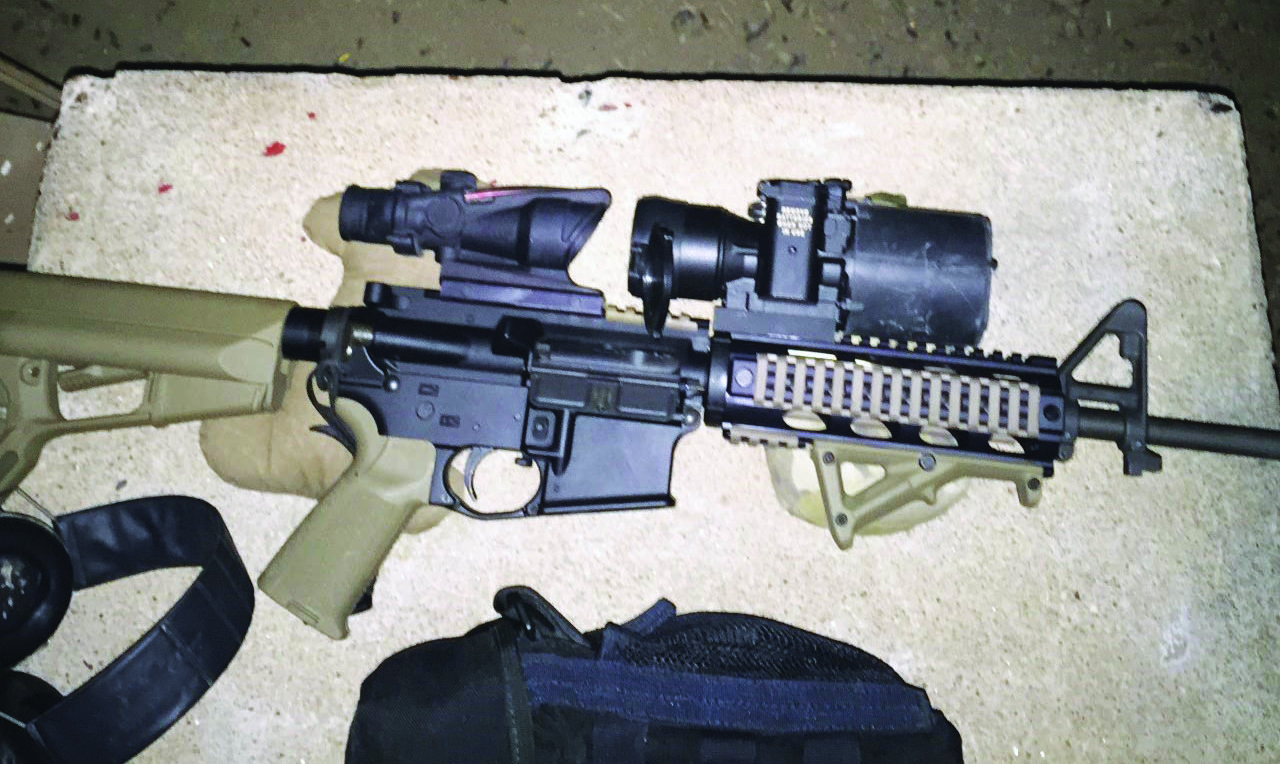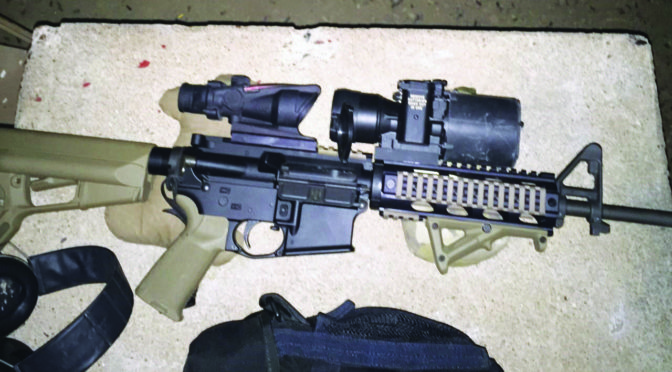Part 2 of 3
by Mark Bunch,
Lincoln Park Pawn,
Royal Gorge Gun Club

Gen 2 Night Vision
Device (NVD)
Major improvements in image-intensifier tubes resulted in Generation-2 NVDs. They offer improved resolution and performance over Generation-1 devices, and are considerably more reliable. The biggest gain in Generation 2 is the ability to see in extremely low light conditions, such as a moonless night. This increased sensitivity is due to the addition of the microchannel plate to the image-intensifier tube.
Since the MCP actually increases the number of electrons instead of just accelerating the original ones, the images are significantly less distorted and brighter than earlier-generation NVDs. Gen 2 tubes last considerably longer than Gen 1 tubes and are generally more durable. Tube life of Gen 2 tubes last over three times as long as Gen 1, or around 5,000 hours. More expensive than Gen 1, the performance is noticeably better and well worth the extra capital required. I would recommend first time NVD purchasers check out Gen 2 and Gen2+ units as a starting point.
Gen 2+ devices are better units than the earlier Gen 2 units. Enhanced performance and the ability to provide increased recognition ranges in lower levels of light are what you are purchasing over Gen 2. Pretty much everyone sells them these days, and US devices will contain tubes made by ITT, Litton etc… Check Cabela’s, Bass Pro and Sportsman’s guide for these entry level units. Examples: AN/PVS-4, AN/PVS-5, SUPERGEN, PNV-57E If you already have a good entry level unit and are looking to purchase the absolute best NVD your money can buy, email or call me directly for a demonstration and a quote.

Gen 3 Night Vision
Device (NVD)
Generation 3 is currently used by the U.S. military. While there are no substantial changes in the underlying technology from Generation 2, these NVDs have even better resolution and sensitivity. This is because the photo cathode is made using gallium arsenide, which is very efficient at converting photons to electrons. Additionally, the MCP is coated with an ion barrier, which dramatically increases the life of the tube, up to 10,000 plus hours for some tubes. One of the key specs to look for is the line pair per millimeter rating of the NVD. The higher quality units will have 64 lp/mm or greater. This rating is generally indicative of the quality of the tube you are getting, however lp/mm is only one of three important specifications you will want to check into. Examples: AN/PVS-7, AN/NVS-7, AN/PVS-10, AN/PVS-14, AN/PNVS-14, CNVS-4949, PN-21K .
Gen 4 Night Vision
Device (Gen 3 Auto
Gated NVD)
This is a tricky one as technically there is not really a Gen 4 classification, according to the US Army. When it was initially introduced the US Army recognized the Gen 4 technology classification. However, after testing reliability and life span of the Gen 4 the Army determined that this technology did not meet their strict requirements and thus recanted the Gen 4 definition. So what does this mean for someone looking for the best equipment they can get? In terms of performance Generation 4 equipment is only marginally equivalent to or slightly better than most Gen 3 autogated NVDs. There are only four levels/or generations of night vision, Gen 0, Gen 1, Gen 2, and Gen 3.
Some manufactures will claim they are selling you a Gen 4 Night Vision Device, but much like car dealers who sell used cars calling them pre-owned it is simply a play on words. Those sellers are calling the 4 levels of night vision generations, Gen 1, Gen 2, Gen 3 and Gen 4, however that is just a clever attempt to play on words to confuse the end user/buyer, so Sentinel readers beware! If someone is trying to sell you, or tell you they have a Gen 4 Night Vision device, that simply isn’t likely to be accurate.
In the Army night vision testing of proposed Gen 4 Night Vision Devices, the very nature of the 4th Generation technology made it more prone to failures and reduced its life expectancy as compared to quality Gen 3 equipment. Pinnacle tube Gen 3 autogated models offer the NVD user spectacular performance, much better tube longevity, increased reliability and a lower investment cost. Although some people feel that Gen 4 gives a little better image, it is really a bit of a toss-up and it often comes down to which unit has the better individual image tube. Gen 4 tubes simply did not deliver and even if you could find one of these early designated Gen 4 test units, I do not recommend purchasing it. The questionable increase in performance is more than off-set by all the negative aspects of a thin or completely removed ion barrier. Examples: Gen 3 pinnacle auto gated tube AN/PVS-22, NVS-22. This is my Sako TRG 22 in .260 Remington with a Knights Armament PVS 30. Anyone interested we sell these Gen 3 Pinnacle PVS 30s for $5,500 but we have a special for Sentinel readers for $4,999.
Understanding Resolution and Signal-to-Noise Specifications
The two most important specifications for any night vision device are resolution and signal-to-noise ratio. In fact, one of the main parameters for determining whether a night vision device can be exported is the multiple of these two specifications, also known as Figure Of Merit. If the NVD you are considering buying is subject to ITAR (International Traffic in Arms Regulations) it is a pretty good bet that you are looking at a high quality NVD. Conversely, if there is no restriction attached to the unit you are considering, it is probably a POS.
Resolution
Much like a television or computer screen, the more information that can be packed onto your night vision image tube, the clearer it will be. Measured in line pairs per millimeter (lp/mm), the higher the specified lp/mm the better. When you compare an average Gen1+ 25 lp/mm image tube to the typical resolution that you’ll find on a Gen3 tube – 64 lp/mm – it’s pretty obvious that a Gen3 tube is going to be better. No matter how you slice it, 150% better resolution means a better image.
Signal-to-Noise Ratio
However, a high resolution isn’t the only thing you should be looking for in your image tube. Though it’s a good start, keep in mind that the real function of a good night vision system is to perform well under incredibly low light conditions. This is where the signal-to-noise measure becomes important.
Signal-to-Noise provides a measure of the light signal that reaches your eye divided by the perceived noise that you actually see. For example, “noisy” tubes look like there’s a snowstorm going on inside the tube. Even a very bright tube that’s full of snow (noise) is going to produce lousy results. A good Gen 3 tube will have a signal-to-noise ratio in the high 20s while Gen1+ ratios are much lower, generally sitting in the single digits. My two best NVDs are a PVS-22 which has a photocathode response of 2200, a signal to noise ratio of 27, and it also provides 64 lp/mm resolution. I also have a couple of Knights Armament PVS 30s with a photocathode response of 2300, signal to noise of 25 and also 64 pm/mm resolution.
Bottom line, the best image tubes have BOTH a high resolution (as high as 73 lp/mm) and a high signal-to-noise ratio. While most night vision devices will provide specifications detailing resolution, only the highest quality tubes provide data sheets detailing their signal-to-noise ratios.
Photocathode Sensitivity
Photocathode sensitivity is a measure of how well the image intensifier tube converts light into an electronic signal so it can be amplified. The measuring units of photocathode sensitivity are micro-amps/lumen (µA/lm) or microamperes per lumen. This criterion specifies the number of electrons released by the Photocathode (PC). PC response is always measured in isolation with no amplification stage or ion barrier (film).
Therefore, tube data sheets (which always carry this “raw” figure) do not reflect the fact that over 50% of those electrons are lost in the ion barrier. For most 3rd generation image intensifiers the photo response is in the 1800 µA/lm (2000 µA/lm or greater for the latest Omni VI Pinnacle tubes), the actual number is more like 900 µA/lm. The higher this number, the better, and when I purchased my PVS-22 for a King’s ransom, I could have gotten a unit with a 2700 photocathode response for a few thousand more. Thanks to one of my USMC buddies, Jeff Belanger, for convincing me I needed this NVD, Semper Fi! Jeff is an excellent gunsmith and a good friend and we go back and forth costing each other money on cool expensive things, lol.
(Editor/GG: The final, Part 3, is next week.)
The author, Mark Bunch, owns and operates Lincoln Park Pawn and Gun and 1 mile plus gun range with his business partner John Hudson in Cañon City ,Colorado. Mark is an NRA certified Law Enforcement Firearms Instructor in pistol, shotgun, police weapons, CMP rifle, Urban Rifle, Sub Gun and Long Range Rifle Disciplines and an internationally recognized long distance competitive shooter. He can be reached via email at: lincolnparkpawn@hotmail.com, OR rggcpresident@live.com or the old fashioned way via landline at 719-276-3030.

